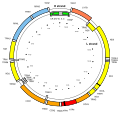Mitochondrion: Difference between revisions
CSV import |
CSV import |
||
| Line 27: | Line 27: | ||
{{stub}} | {{stub}} | ||
<gallery> | |||
File:Animal_mitochondrion_diagram_en.svg|Animal mitochondrion diagram | |||
File:MitochondrionCAM.jpg|Mitochondrion CAM | |||
File:Electron_transport_chain.svg|Electron transport chain | |||
File:Chondrocyte-_calcium_stain.jpg|Chondrocyte calcium stain | |||
File:HeLa_mtGFP.tif|HeLa mtGFP | |||
File:ERMES.png|ERMES | |||
File:The-origins-of-mitochondrion-related-organelles-A-hypothetical-scenario-for-the.png|The origins of mitochondrion-related organelles | |||
File:Map_of_the_human_mitochondrial_genome.svg|Map of the human mitochondrial genome | |||
</gallery> | |||
Latest revision as of 21:03, 23 February 2025
Mitochondrion
The Mitochondrion (plural mitochondria) is a double membrane-bound organelle found in most eukaryotic organisms. Some cells in some multicellular organisms may, however, lack them (for example, mature mammalian red blood cells). A number of unicellular organisms, such as microsporidia, parabasalids, and diplomonads, have also reduced or transformed their mitochondria into other structures.
Structure[edit]
Mitochondria are spherical to rod-shaped organelles that range from 1 to 10 micrometers (μm) in length. The structure of the mitochondrion is defined by an outer membrane, an intermembrane space, an inner membrane, and the matrix (space within the inner membrane).
Function[edit]
Mitochondria provide energy to the cell in which they reside. They are often referred to as the powerhouses of the cell because they generate most of the cell's supply of adenosine triphosphate (ATP), used as a source of chemical energy.
Origin[edit]
Mitochondria are thought to have originated from a symbiotic relationship between primitive eukaryotic cells and prokaryotic cells. This theory is known as the Endosymbiotic theory.
Clinical significance[edit]
Mitochondrial diseases encompass a group of disorders caused by dysfunctional mitochondria. They are the result of either inherited or spontaneous mutations in mtDNA or nDNA, which lead to altered functions of the proteins or RNA molecules that normally reside in mitochondria.










